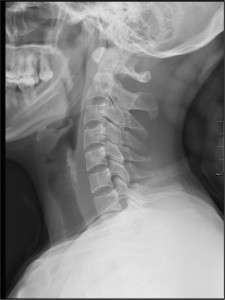One middle-aged patient sought me out in Seattle from the East Coast for a second opinion regarding his neck. He had been disabled since 2001 with chronic pain over most of his body. He had at least 10 additional symptoms of burning, aching, stabbing, and tingling that would migrate throughout his body. He also was experiencing bladder urgency, balance problems, and dizziness. All of these are a result of the body being a state of flight or fight physiology (how the body functions). The medical world has come up with a new diagnosis of MUS (medically unexplained symptoms), which is not correct. The term should be MES (Medical explained Symptoms).
In 2003, a neurosurgeon performed a laminectomy of his neck. That’s an operation where the lamina or the bone over the back of the spinal cord is removed to relieve pressure. He seemed to improve for a little while. In 2005, his symptoms worsened, and in 2009, he underwent a fusion through the front of his neck between his 5th and 6th vertebrae. Again there was a slight improvement but two years later he was in my office with crippling pain throughout his whole body.
Normal studies
As I talked to him, I could see how desperate he was for relief. He also wasn’t sleeping and his anxiety and frustration were a 10/10 on my spine intake questionnaire. I couldn’t find any neurological problems on my physical exam. When I looked at his neck MRI, I could see where the two prior surgeries had been performed, but there were no pinched nerves. The alignment and stability of the vertebrae were also fine. He also had undergone several workups of his brain and the rest of his nervous system. Everything was normal.

When I explained to him that I did not see a structural problem that was amenable to surgery he became understandably upset. He was stuck on the idea that the prior surgeries had helped and that I was missing something. It didn’t matter what I said or how I explained the situation to him. He wasn’t buying it.
What I didn’t tell him was that I had also looked at his scans he had prior to undergoing each surgery. Telling a patient that they did not really need a prior surgery is a very unproductive, unpleasant interaction; I didn’t see why this patient’s prior surgeries were performed. On the first MRI of his neck, there were no bone spurs and the spinal cord was completely free. There wasn’t a structural problem that could have been corrected by surgery. On the scan before the second operation, there also wasn’t a hint of anything that could be causing any symptoms of any type.
The power of placebo
What’s difficult for patients (and physicians) to realize is that the placebo rate for any medical or surgical treatment is between 25-30% or even higher. The response and improvement is not only real but is powerful. It is the result of your body’s own healing capacity. It is a desired response, and you feel less pain.
The pain-killing effects of a placebo are reversed with Narcan, which is the drug used to reverse the effect of narcotics. There is a part of the frontal lobe of your brain that shuts off pain pathways for short periods of time. Another example is the placebo effect of cardiac medications causes the heart rhythms to actually change. Just because a prior surgery or procedure on normal age-appropriate anatomy might have been temporarily effective is irrelevant. It should have nothing to do with current decision-making. I tell my patients “If I can see it, I can fix it” and “If I can’t see it, I can’t surgically correct it.” It’s critical to have a specific structural problem with matching symptoms before surgery becomes an option. Surgery: The Ultimate Placebo
I suggested that he take a look at the DOC website and I would be happy to explain the whole program to him in as much detail as needed. He was so angry that I didn’t think I’d hear from him again.
Early engagement
Over the next couple of months, I received a couple of emails and had a telephone conversation that seemed to go pretty well. He was willing to engage in the DOC protocol and began some of the writing exercises. I had a second phone conversation with him a couple of weeks later that seemed to go even better. He was able to recognize that his thought of me “missing something that needed to be fixed” was an obsessive thinking pattern. I was encouraged and thought that maybe I had been able to break through his “story.”
Time went by and our third and final conversation was dismal. He couldn’t let go of the thought that “something was being missed” and that his seventh cervical vertebra was “out of alignment.” I assured him it was OK. As a surgeon, I am also quite obsessive about not missing problems that I can fix. At this point, it didn’t matter. He’d found a surgeon who was going to fuse his neck.
Injury conviction
Physicians use the term “injury conviction” to describe this phenomenon. It is the relentless pursuit of a cause for your symptoms that is well beyond reason. My concept has changed in that I feel this pattern of thinking becomes its own irrational set of neurological circuits. It is similar to phantom limb pain and my term is “phantom brain pain.” Regardless of whether the original source of pain is there, the symptoms are the same. Rational arguments have absolutely no effect.

Hell
I wrote a post Anxiety and Anger: The Highway to Hell. Unfortunately, if you’re in this pattern, you’re in Hell, and the only way out is through you. The deep tragedy is that if you don’t realize you’re in Hell, you’ll remain there. I never give up, but I have learned to let go when I can’t penetrate that firewall of obsessive thinking. For those of you that have let yourself out this hole, I am open to suggestions as to what gave you the insight to move forward. Awareness is the basis of the entire DOC process and is always the first step.
I don’t know how many more tests and surgeries he’ll undergo over the next 30 years. The personal cost to him and society will be enormous.
What’s puzzling is that if any of the surgeons who’d chosen to operate on this man’s essentially normal anatomy were examined by a board examiner about their indications for his surgeries, they’d be failed immediately for giving a “dangerous answer.” It’s our medical responsibility to you to not offer risky procedures that have been documented to be ineffective.
Video: “Get it Right the First Time”
